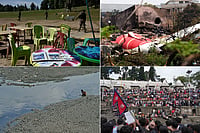New Fruit At The Bazaar
- Apples from Arunachal Pradesh
- Khasi mandarins from the Northeast
- Bananas like Nendran from Kerala and Malbhog from Bihar
- Figs from Karnataka and Maharashtra
- Sapodilla (Chikoo) from West Bengal
- South Indian mangoes like Imam Pasand, Rumani, Neelam and Mallika etc
***
Buying fruits today, it’s very likely that what’s on offer is US-grown apples, deep red and waxed to perfection, or juicy pears from China, individually cushioned in foam to prevent any damage. With competition like that, it’s no surprise that the desi, pockmarked Indian apple and insipid pears were losing out. But things are looking up now for the indigenous fruit market. The National Horticulture Board (NHB) and its network of Indian fruit growers and cold chain specialists are beginning to put in place a mechanism that will, hopefully, completely overhaul the Indian fruit market in about two years. Not only will the fruit quality improve dramatically with better pre-harvest advice and post-harvest refrigerated transport, plans are also afoot to market a host of fruits—till now sold locally in the regions where they are grown—at the countrywide bazaar.
If the plan plays out according to script, Gulf dates from Kutch will be sold in Arunachal Pradesh, Khasi mandarins from the Northeast will be available in Gujarat, Ambri apples from Kashmir will rule the dining table in Kerala and Nendran bananas from the coastal state will be easy pickings in Delhi. Cold chain stores will be set up in a month’s time at four railway stations in New Delhi by Fresh and Healthy Enterprises Limited—owned by the Container Corporation of India Limited—to further this initiative.
Among Indian fruits, it’s apples that are feeling the squeeze. According to president of the Indian Apple Growers’ Association Ravinder Singh Chauhan, imported varieties accounted for about 30 per cent of total apple sales in the country in 2009. “That the production of Indian apples was low last year certainly helped them increase their sales. Imports have to be banned,” he says flatly. NHB director Bijay Kumar, however, sees imported fruits as something that’s pushing Indian fruit growers to pull up their socks. “If we do not respond the way we are planning to, they will certainly take over,” Kumar says. “The idea is to encourage farmers with remunerative prices to cover the cost of additional investment to improve quality of fruits. If an Arunachali is going to be content with just selling his mandarins in Assam, there is going to be little improvement.”
Many farmers’ organisations have already approached the NHB. Since May last year, the NHB has also held several fruit shows in cities to enable farmers to link up with consumers directly and invest in refrigerated transport and better cultivation practices. This summer, a litchi show will be organised in Mumbai; litchis are far more scarce in the west and south unlike in the north and east where they grow abundantly. Likewise, a month-long sale of south Indian mango varieties—like Imam Pasand, Malgova and Banganapalli—will be held in the two Dilli Haats in the capital in May. “On the other hand, north Indian mango growers can come with their produce down south in June for that’s when mango season begins to end here,” says R. Prabhuram, secretary of the Tamil Nadu Mango Growers’ Federation.
Indian fruit lovers have never had it better. With some of the finest fruits from across the world already at their disposal, they can now finally look forward to a varied palate drawn from the best fruits that India has to offer. “The scenario is going to be very different in two years. The thrust now is to ensure that these measures do not just remain small ripples but actually become a movement,” concludes Kumar.


























